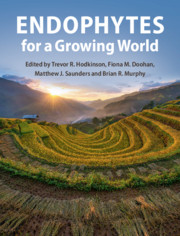Book contents
- Endophytes for a Growing World
- Endophytes for a Growing World
- Copyright page
- Contents
- Contributors
- Preface
- Part I Introduction
- 1 Endophytes for a Growing World
- Part II Role of Endophytes in Growth and Biotic and Abiotic Stress Resistance
- Part III Diversity and Community Ecology of Endophytes
- Part IV Endophytes for Novel Biomolecules and In Vitro Methods
- Part V Application and Commercialisation of Endophytes in Crop Production
- Index
- References
1 - Endophytes for a Growing World
from Part I - Introduction
Published online by Cambridge University Press: 01 April 2019
- Endophytes for a Growing World
- Endophytes for a Growing World
- Copyright page
- Contents
- Contributors
- Preface
- Part I Introduction
- 1 Endophytes for a Growing World
- Part II Role of Endophytes in Growth and Biotic and Abiotic Stress Resistance
- Part III Diversity and Community Ecology of Endophytes
- Part IV Endophytes for Novel Biomolecules and In Vitro Methods
- Part V Application and Commercialisation of Endophytes in Crop Production
- Index
- References
Summary
Endophytes are any microbes that can live within plants. We divide them into three major functional groups: endosyms (endosymbionts), endopaths (pathogens) and endosympaths (those that exist in both forms along a mutualism–parasitism continuum). Within these groups, endophytologists recognise harmful pathogenic microbes and a diverse range of beneficial/commensal microbes, including bacteria and archaea, such as diazotrophs, and fungi, such as the vertically transmitted clavicipitaceous endophytes, the generally horizontally transmitted class 2 fungal endophytes, mycorrhizal fungi and dark septate endophytes. This chapter introduces the science of endophyte biology and its application for a world population that is projected to grow to over 9 billion by 2050. It explores the potential of endophytes for improved agricultural and silvicultural sustainability including: yield improvement and nutrition; biocontrol of pests and diseases; and abiotic stress resistance in the context of climate change. It outlines how bioprospectors are using endophytes as sources of novel metabolites for the pharmaceutical and biochemical industries, and describes how endophytes can be used in vitro to elicit the increased production of known secondary metabolites from plants.
- Type
- Chapter
- Information
- Endophytes for a Growing World , pp. 3 - 22Publisher: Cambridge University PressPrint publication year: 2019
References
- 6
- Cited by

